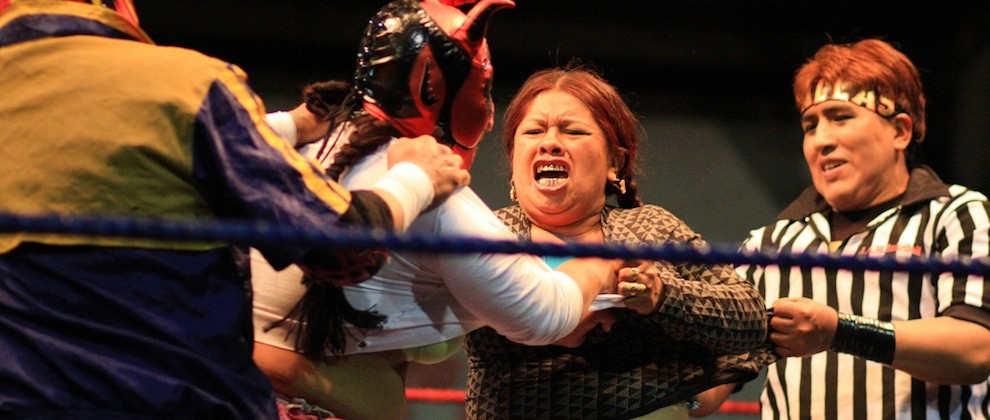* image bolivia.for91days.com
The afternoon starts with a minute’s silence for the pope, who died the night before. But that’s the last mark of respect we’ll be seeing today.
When ringmaster John Peralis takes the mic in shiny shoes and a curly perm to announce the first of seven 20-minute bouts, the crowd, each paying a US$1 entrance fee, responds by screaming, “Give it to him.”
It’s Sunday afternoon at a breeze-block gym in El Alto, the poverty-stricken slums that tower above downtown La Paz, Bolivia.
Whole families sit ringside and grandmothers, dressed in traditional Cholita dress of flowing skirts and bowler hats, prepare to lob popcorn viciously at the losers.
Welcome to lucha libre wrestling, the latest sports craze sweeping Bolivia.
Strike a blow
“Lucha libre was born in Mexico but it has developed a huge following in Bolivia since we first allowed women into the ring last year,” says the event’s ebullient organiser Juan Carlos Chavez.
“Life is tough here and lucha libre is a battle of good versus evil – just like real life.”
Bolivia has a tradition of ritual fighting (tinku), which brings together rival villages in the Potosi department for a symbolism-loaded scrap during the Fiesta de la Cruz. But this afternoon’s no-holds-barred grudge match takes tinku and gives it a twist of Big Daddy-style glamour.
First is an all-male round to warm up the crowd. Luxor makes a dramatic entrance in a devil suit while his opponent, Picodo, dressed like a member of Slipknot, arrives to a chorus of the German industrial band, Ramstein.
As the first blood of the day is drawn, a young mother lifts her baby onto her shoulders for a better view.
Triumphant, Luxor stands astride the ropes, dripping sweat and blood. “I am the best,” he screams. “I am the best.”
As his opponent tumbles exhausted from the ring, a slight women steps forward from the crowd to land a cheeky blow to a particularly vulnerable area.
Action packed
As the afternoon progresses, the bouts get increasingly bloody with blows stronger than the whiff coming from the toilets. By late afternoon, the crowd has reached fever pitch for the first of the all-women rounds.
With a cry of, “A la luche” (let’s fight), they take to the ring in spandex, boots and masks.
As the bell rings, referee Barba Negra, a Grizzly Adams type with a flowing mullet, tries to bring a sense of order to a fight that is part WWF pantomime, part bloodfest.
It’s probably the only wrestling match whereby the referee ends up taking an active role. When the wrestlers roll out of the ring, they just carry on fighting anyway.
Star turn
Back stage, the star turn, Satanica, is getting into costume. By day Jenny Almarez works in a La Paz supermarket, but tonight she will take to the ring wielding a flaming torch to the strains of Black Sabbath.
“I came to watch and something just grabbed me. The wrestlers looked like film stars,” she says, finishing her Gothic make-up.
“Now I fight, I take it very seriously — the night before a fight no booze, nor sex.”
Her opponent, Jennifer Two Faces, takes to the ring in a figure-hugging leotard and gold boots. After trading insults, they launch into a catfight involving hair pulling and the improvised use of a soiled nappy commandeered from the crowd.
It makes the male bout look like a petty scrap at the local kindergarten.
“I always go home covered in bruises,” smiles Jennifer, who is declared the winner after setting Satanica’s legs on fire.
“My mum says wrestling is a man’s sport, but we prove that it’s the women in Bolivia who really have balls.”
What did you think of this story? Post your comments below.
This story first appeared in the Weekend FT in 2005. Liked this? Try also The Tinku festival in Bolivia.
